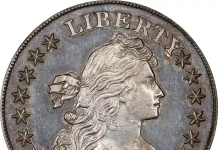Calls for the Nickel to be Discontinued
MARKET REPORT
By Mike Fuljenz
“In 2024, each five-cent nickel cost 13.8 cents to produce, resulting in a loss of 8.8 cents on all 202 million of the coins that were produced.”
In the February/March 2025 issue of COINage, my column asked the rhetorical question, “Do ‘Pennies’ Make Sense?” I concluded that in the United States they do not. U.S. President Donald Trump posted his own statement on social media about cents and, without making mention of my column, expressed the same views as mine.
Now, what about the nickel and paper dollar? Not so fast! While there are solid financial reasons to eliminate both of these, I believe we need to take a stairstep approach.
Canada eliminated its penny and replaced its paper dollar with a coin. Anecdotally, Canadians I have spoken with told me it has worked well. But in this column, I want to address the nickel, or five-cent piece, which, in the future, should be the next U.S. coin to be eliminated, or at least modified.
The one-cent piece, or penny as we call it, costs almost four cents to make, at a loss of nearly three cents apiece. Since 2006, the U.S. Mint has lost money making pennies to the tune of billions of dollars. In 2024, the U.S. Mint manufactured 3,172,000 pennies at 3.7 cents each, resulting in a loss of $85 million.
In 2024, each five-cent nickel cost 13.8 cents to produce, resulting in a loss of 8.8 cents on all 202 million of the coins that were produced. This resulted in an $18 million loss for the U.S. Mint.
If we eliminate the penny, there will probably be more demand for nickels, so, over time, the losses to produce that coin will likely grow.
The Act of May 16, 1866, began the nickel series, which became known as the “Shield Nickel,” eventually replacing silver-based half-dimes. Each nickel weighed five grams and was composed of 75% copper and 25% nickel. It had a diameter of 20.5 mm.
Beginning with the Liberty Nickel, which was struck from 1883 to 1913, the nickel had a diameter of 21.2 mm. The same five-gram weight and those metrics are the same as today’s Jefferson Nickel.
To save money on producing the nickel, the U.S. Mint could reduce the size or change the nickel composition to a different combination of metals. Both of these ideas have been implemented with different denominations, such as the penny, in the U.S. Mint’s history and by mints in other countries.
The public would not confuse a nickel, which weighs five grams and has a diameter of 21.2 mm, with that of a dime, which weighs 2.27 grams and has a diameter of 17.9 mm, even if it were reduced in size and weight by 20%.
Canada has a nickel of 3.95 grams. Spain’s nickel weighs 3.92 grams. Finland’s nickel is also 3.92 grams and Australia’s nickel is 2.83 grams. So, we could consider reducing the five-gram weight of our nickel by 20%, to 4 grams.
The U.S. Mint could also consider doing what Canada did and have a nickel made of mostly steel. Canada’s nickel is composed of 94.5% steel, 3.5% copper and 2% nickel plating.
In 1857, the price of copper had increased so much that the U.S. Mint significantly reduced the weight of the cent from 10.89 grams to 4.67 grams in the transition from the Braided Hair Large Cent to the Flying Eagle Cent.
The cost of nickel is currently $7 per pound; copper is $5.10 per pound; zinc is $1.34 per pound and rising; aluminum is $1.15 per pound; and steel is only 47¢ per pound. Various countries use many of these metals in their coinages. As I pointed out, Canada’s nickel, which is smaller, weighs less and uses inexpensive steel, is less expensive to produce than the current five-cent nickel minted by the U.S. Adopting some of these production standards could save the U.S. Mint millions of dollars.
Along with size and metal composition, the U.S. Mint must also consider die life and ease of striking when it comes to different compositions of coin blanks. However, if Canada and other countries can mint their coins with far less expensive alloys, it stands to reason that the U.S. Mint can and should continue to consider doing it as well.
Let’s eliminate the penny and, for now, change the weight and composition of the nickel to probably save about $100 million per year. After all, in 2023, the Federal Reserve noticed that a declining 16% of transactions were made with cash payments.
UPDATE ON GOLD OVER $3,275 PER OUNCE
The primary engine for gold’s surge is 24 straight years of high and rising deficits, plus the new wave of inflation since 2021. America’s debt-to-GDP ratio will reach 140% this year and other nations with such a high ratio have had a long history of slow to no growth: Venezuela, Japan, Italy, Greece and Portugal. Our annual deficit-to-GDP spending is also near 7%, second only to Brazil, double the EU nations and most other rich nations. When high levels of debt cripple a nation it can’t grow, and their currency goes into decline.
Soaring deficits during the financial crises of 2001 to 2011 sent gold up from $260 to $1,500. After a pause, gold began a second rise to $3,000, also on soaring debts, this time with inflation added.
As gold climbs in response to weak currencies and weak stock markets, during the second half of 2025 my advice is to continue creating your own gold (and silver) standard by accumulating bullion coins and even better-performing rare coins.












